When I talk to many people who enjoy road tripping in the United States, I’m often surprised that many are afraid to consider a road trip on the other side of the pond. Planning a European road trip can sound overwhelming, especially if you’ve never been to Europe before. However, you’d be surprised that it’s really very manageable and a very affordable way to see Europe.
For the whole first decade of the 21st Century my family worked on mastering the American road trip. We’ve cruised from coast to coast numerous times (six to be exact in each direction), and driven from the North to the South and vice versa more times than we could keep track of. On our many American road trip adventures, we’ve visited many national monuments, parks, historic battle fields, road side attractions, and much more. We’ve even flown to Alaska and Hawaii and road tripped over there as well! On our American adventures we’ve visited all 50 states in addition to our nation’s capital, Washington DC.

Eventually, in 2015 we decided to take our love for the road overseas for the first time. Our first European road trip was an experience we’ll never forget. We enjoyed it so much that we’ve gone back three additional times since. To date we’ve driven through 18 European countries, and have learned a great deal about traveling around Europe by car. This article is intended to provide helpful information on how to go about planning a European road trip.
Mapping out a European road trip
Most road trips are started on paper, with a map and a highlighter or pen, or perhaps on the computer plotting out destination points electronically. Planning a European trip starts the same exact way; however, there is a little bit of an art to it. I’ll explain.
Step 1: Pick a region
Europe is big with many countries that greatly differ from each other. The best plan of action is to start by choosing a region of Europe that you would like to explore. Lengthier trips can include multiple regions; however, if it’s your first time planning a European road trip, it may be best to stick to one region for reasons I will discuss in this article.
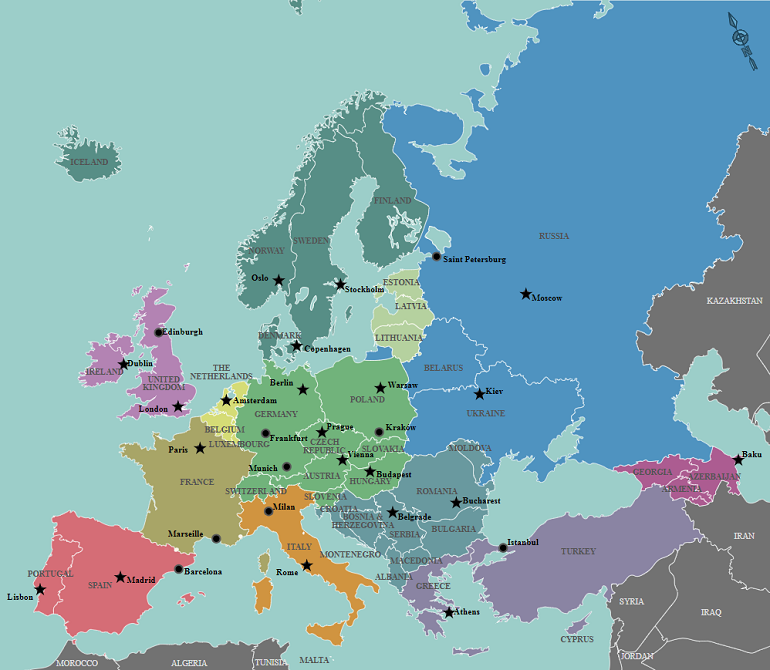
Here are some great examples of regions to plan a European road-trip.
- Italy – (one could easily spend weeks just driving around Italy alone)
- Iberian Peninsula – (Spain/Portugal)
- UK – (England, Wales, Scotland – these can even be broken up into separate trips)
- Ireland – (Ireland, Northern Ireland)
- Upper EU – (France, Belgium, Netherlands, Northwest Germany (Rhineland), Luxembourg)
- Alps – (Switzerland, Liechtenstein, Austria, Southern Germany (Bavaria))
- Mid-East Europe – (Czech Republic, Slovakia, Hungary, Eastern Austria)
- Balkans – (Slovenia, Croatia, Bosnia & Herzegovina, Montenegro)
- Scandinavia – (Denmark, Sweden, Finland, Norway)
While this list obviously doesn’t include all the possibilities, it’s a great place to start if you don’t know where to.
Step 2: Highlight points of interest
After you have chosen the region of Europe you want to explore, it’s time to start researching points of interest! This is the fun part, and the part I enjoy the most when planning a European road trip. What do you want to see? Where do you want to go?
Like most people, there are the famous points of interest we all want to see – such as the Colosseum in Rome, the leaning tower of Pisa, and the canals of Venice. These would be perfect points of interest to highlight for an Italian road trip; however, don’t stop there! Sometimes the best places to see are the ones you don’t know exist.
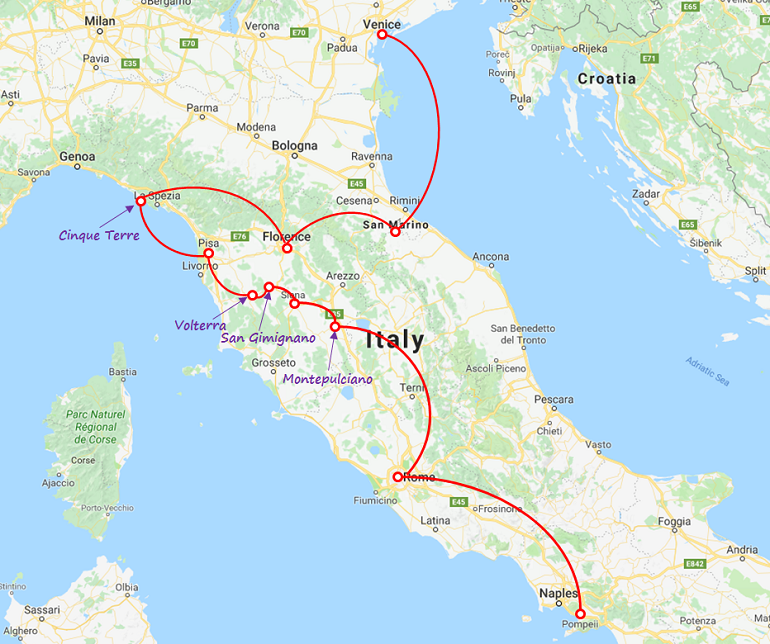
While planning your European road trip, look carefully at the map. Look at the names of the towns and cities between the major places you want to visit. Make note of these and write them down. Don’t worry yet about how you’ll get there (which roads to take). Once you have enough of them noted – start googling! You’ll be surprised to find a plethora of good information about these locations, especially in travel blogs. There are many travelers who are more than happy to share their experiences with you. Sometimes the places you find accidentally are the most enjoyable!
Step 3: Connect the dots
Now comes the challenging part of figuring out the timing of it all and planning your route. The easiest way to start this process is by utilizing a good mapping program like Google Maps (which I use). Plug in a starting city and an ending city and see what it says the driving time will take you. Make sure you set it to morning or mid-day for accurate results. I usually add some time to this amount to account for fuel , restroom, or additional breaks (depending on the length of the drive and the needs of your passengers).

For a family of five this is a general rule of thumb I use: For every 3 hours of straight driving time between points of interest, I usually add about 30 minutes. For example, if the drive said it would take 5½ hours, I’d add an hour and plan for it to take 6½ hours.
The more challenging part is figuring out how long to spend at each point of interest you choose. This part is entirely subjective and depends on what your family likes to do, and the pace you normally enjoy. My family enjoys a faster pace than most people I know, and usually won’t spend as long in one destination as might be recommended. For example, while planning to see Rome, most sites I read suggested staying 3 to 4 days here. My family and I saw most of what we wanted to see in a day and a half. Determining the length of time to spend in any destination is completely dependent on your travel style. It will help you determine the length of your trip as well.
What if I don’t know how long to plan for tours or sight seeing at certain locations?
The best way to determine how long to spend on a tour or sight seeing is by doing lots of research on the destination. TripAdvisor forums are an excellent source for determining how long to spend at places. Other travelers like myself are happy to share their experiences and often give great recommendations. Official websites for certain attractions often state how long a typical visit takes as well. Just remember, as I’ve learned over the years, that things always take longer than you think they will, so plan accordingly.
Step 4: Scout lodging options
While I often wait until I have everything else in the plan solidified before actually reserving lodging, I will often look at various lodging options during the planning process. Unlike the USA, where every decently large town has a Holiday Inn Express or a La Quinta Inn, Europe is extremely different when it comes to lodging choices. Different countries can provide varying options on accommodation choices and prices can vary as well. While I also check hotel websites and search engines, I like to use VRBO by HomeAway. Similar to AirBnB, I’ve found several great deals using this site for apartments and homes for rent across Europe.
Save money staying in between destinations.
One of the best parts of driving around Europe (versus taking trains), is that you can usually save a lot of money by staying at the “in-between” places trains cannot get to. I’ll give you a perfect example of this. When my family and I were planning our travels in Switzerland (which is a VERY expensive country), we planned to spend one day in Lucerne, and two days in Interlaken/Lauterbrunnen. The map below shows you their locations and proximity to each other.

Originally we planned on spending one night in Lucerne, and two nights in Interlaken; however, when researching hotels and apartments, they were all extremely high! One night in a decent hotel in either of these cities cost upwards of $250 – $300 a night! When you multiple that by three nights and add taxes and fees you’re looking at over $1000!
I knew there had to be a cheaper way, and there was. Instead of going with our original plan, I decided to look in the middle of the two cities for a place to spend all three nights. I discovered a wonderful looking Swiss chalet available with two LARGE bedrooms, full living room, and kitchen. It wound up costing us $417 total for the three nights averaging $139 a night (total cost). Compare this to a small hotel room at over $300 a night and this was a great deal!

The chalet was in a lovely quiet Swiss town of Hasliberg. The town was full of similar looking chalets, and had a breathtaking view of the Swiss Alps! This turned out to be one of our favorite places that we stayed during our entire trip, and like I said earlier – if we had traveled by train, we couldn’t have stayed here. Having the car helped!

The drive to Lucerne took an hour from here, and Interlaken required a 40 minute ride in the opposite direction. However, saving the amount of money we did for the lodging made it well worth it. Plus, we would have missed out on a very authentic Swiss stay with an absolutely amazing view!
Other Important Information
There are some other important factors to keep in mind when planning a European road trip. Some of these may be obvious, especially if you’ve traveled international before. However, some you may not be aware, so it’s better to be informed.
International Driving Rules
While almost all European countries drive on the right side of the road like the US does, there are a few (four) that do not. The United Kingdom, Ireland, Malta, and Cyprus are the only European nations that drive on the left side of the road. I’ve driven in Ireland and while the experience at first was a bit disorienting and a little ‘weird’, it was easier than I thought it would be, and I was used to it within a couple of days. I wrote an article specifically on this subject if you would like some detailed information regarding the experience.
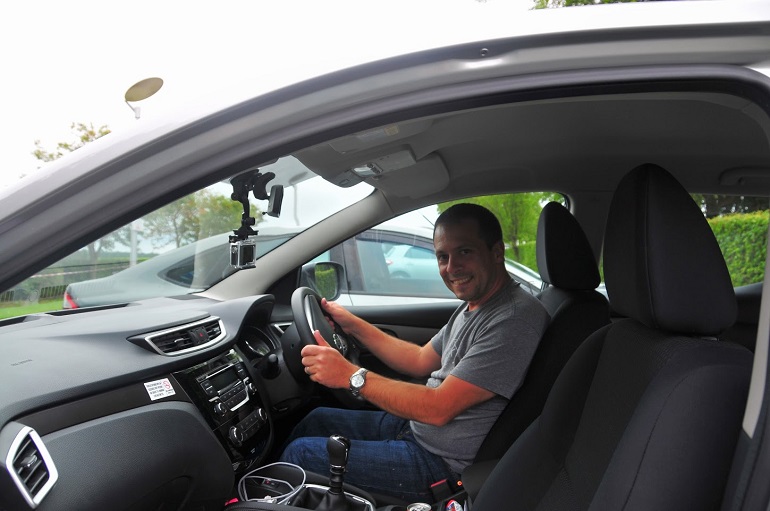
International road signs differ some from American road signs, so if you’re thinking of planning a European road trip and haven’t driven overseas before, I strongly advise you to get familiar with these. Most are fairly similar in shape and color, however there are a few that can be quite baffling to an American.

Crossing borders
If you plan to cross country borders using your rental car in Europe, the most important step is to verify permission to do so with the rental car provider. Many rental car companies in Europe restrict travel to certain countries. Doing so will likely void your contract and you will be liable for the fees associated with that violation. Therefore, if you plan to visit multiple countries on your trip, make sure you choose a car rental company that allows travel to these nations.
When planning a multiple country European road trip, it is much more cost effective to begin and end the trip in the same country. Many European rental car agencies charge extremely high drop off fees ($1000+) for dropping off a rental in another country.
Are their border controls between European nations?
Most countries in Europe are part of the EU, and have borders much like we do between states (ie: a welcome sign and that’s all). However, there are some that maintain their sovereignty with closed borders requiring travelers to enter via a fully manned border checkpoint. While it’s natural to expect only the non-EU nations to have these border controls, some EU nations have them as well (such as Slovenia and Croatia). Waiting in line for some of these border stations can cost you a lot of time, so plan accordingly. The longest we waited was about 1½ hours; however, I have heard of wait times reaching as much as four hours to cross at some locations.
What will I need to cross the border?
While the answer to this question relies heavily on what border you are crossing, you will definitely need your passport, rental documents, and proof of insurance for the vehicle.
Insurance
Vehicle insurance for one country in Europe may not be valid for the next, so it’s very important to make sure you have the proper coverage prior to entering the country. Your rental agreement should state what countries you are allowed to travel between and which countries you are covered in.
When we traveled through some of the Balkan nations (Bosnia & Herzegovina, and Montenegro) it was required to have additional insurance not provided with the rental agreement. This can usually be purchased right at the border, however certain smaller border stations do not offer the option to purchase it on the spot, so be aware of this as you’re planning your trip. Below are examples of what this insurance paper looks like if purchased on the spot.

An easier way of obtaining this additional insurance is to have a “green border crossing card” in your possession. This card can be issued from your rental company usually at an extra charge, though some companies will include it with the rental at no additional fee if it’s initially requested upon booking. This card lists the various nations it is good for right on the card using a 1 or 2 letter country code. The below picture shows what the card looks like and below it is a key to the country codes. I color coded the list of countries to show which countries are covered on this card. (Green = covered, Red = not covered, White = not listed)
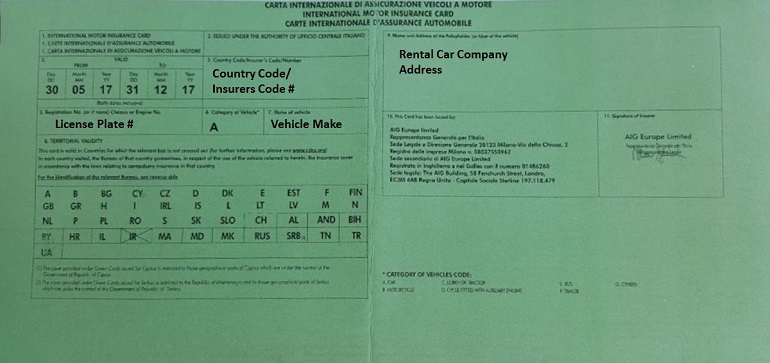
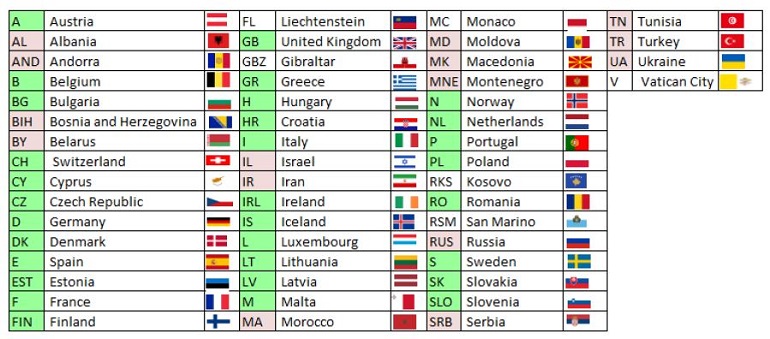
Speed Limits, Tolls, and Restricted Driving Zones
Much like the United States has many states where the speed limits, traffic rules and laws vary slightly, the same goes for driving in Europe. It is important to understand at least some basics regarding these for the countries you plan to drive in prior to your visit.
Speed Limits
Speed limits are posted in same way in all European nations, however just like the United States, some places are much stricter about obeying these limits than others. For example, Switzerland is extremely tight on their speeding laws and have hidden traffic cameras EVERYWHERE. They will nab you for going even 5 kph (3 mph) over the limit which can easily be done accidentally. However, in Croatia, where the limit on the motorway reaches 130 kph (80 mph), expect most vehicles to be doing upwards of 150-160 kph (93 – 99 mph). Some even much faster! While Germany’s autobahn is widely known for its excessively fast drivers, I’ve driven on it as well and in my opinion, it doesn’t compare to the Croatian motorway, which to me felt like I was competing in Formula 1.

Tolls / Vignettes
Much like the US, many countries in Europe require drivers to pay a fee for using the motorways. These fees are collected in two different ways depending on which country you are traveling through in Europe.
Tolls
Tolls in European nations usually operate on a pay-per-distance system. That means you pay an increasing fee according to the distance traveled. Most tolls are still the traditional manned tollbooths where both cash and card are widely accepted. However, there are a few places where there are only “barrier-free” tolls. These are the ones that capture your vehicle’s toll tag or license plate and bill you electronically. So far, these can be found in Ireland, Portugal, Spain, and France, however other countries may be adopting them as well.
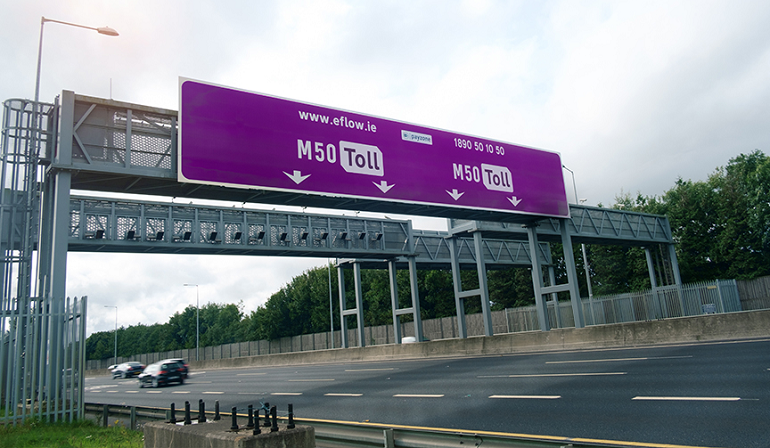
If you plan to travel in a country that has barrier-free tolls, pay attention to which routes you plan to take while planning your trip to learn the location of these tolls. For instance, while planning our Ireland road trip, I discovered the existence of the M50 toll that is on the ring road around Dublin which features this type of toll. It’s important to be aware of its location because this particular toll’s fee increases with every day it’s not paid. Therefore if you were totally unaware and went under it with your rental vehicle and returned home some 10 days later – you would eventually receive a nice fee in the mail.
These barrier-free tolls are usually well marked and have large signage for drivers; however it’s always best to be aware of their locations prior to taking the trip.
Below is a list of current European countries using the toll system.
- Croatia
- France
- Italy
- Spain
- Norway
- Germany
- Poland
- Serbia
- United Kingdom
- Portugal
- Greece
- Ireland
- Macedonia
- Turkey
Vignettes
Some European countries require visitors to purchase a vignette to drive in their country. A vignette is a form of road pricing or road tax that’s used instead of tolls. In the form of a windshield decal, these can be purchased at gas stations, rest stops, and post offices around the border of the country. Some countries allow you to purchase a vignette online in advance. Most are not expensive and can be purchased for various lengths of validity, usually 7-10 days. Switzerland is the only country where a short term vignette is not available, therefore travelers must purchase the vignette for the entire year. Below are examples of what some vignettes look like for various countries.
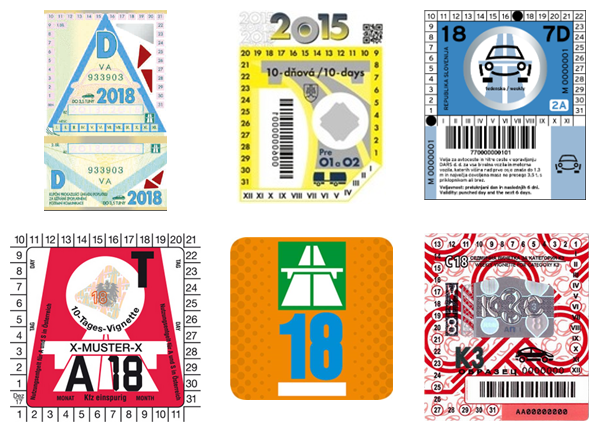
Vignettes are verified by state officials such as border guards and national police. If you are caught driving without a valid vignette you may face hefty fines which are often required to be paid on the spot.
Below is a list of European nations requiring vignettes.
Next to each in parenthesis is the shortest duration vignette available for rental cars (under 3.5 tonnes). Each is linked to the official website where additional information can be found.
- Czech Republic (10 days)
- Slovakia (10 days)
- Slovenia (7 days)
- Austria (10 days)
- Switzerland (1 year)
- Hungary (10 days)
- Bulgaria (2 days – weekend)
- Romania (7 days)
Restricted Driving Zones
Another thing to be especially aware of if you plan to drive in Europe are restricted driving zones. These zones restrict traffic unless the driver has a special permit or permission to be in the zone. This is especially common in Italy in places such as Rome, Florence, Pisa, and Milan and are known as “ZTL zones”. While these zones are supposed to be marked really well with signs (see photos below), they can easily be missed while driving in Rome traffic or through the narrow streets of Florence.
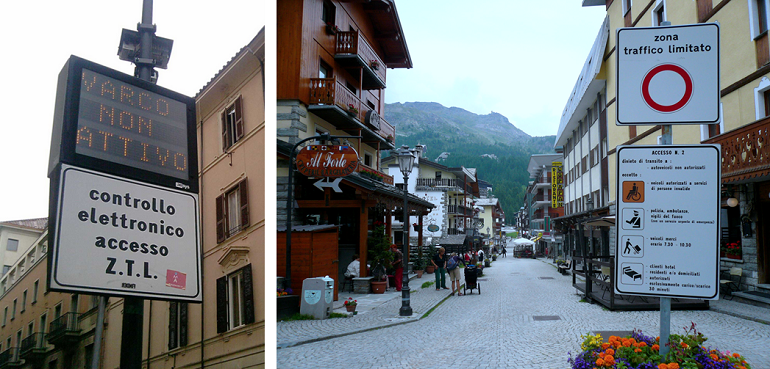
Some of these zones are only active during certain hours. Electronic systems are sometimes used to notify drivers when the zone is open or closed. For example, Florence uses signs with green or red lights (below).
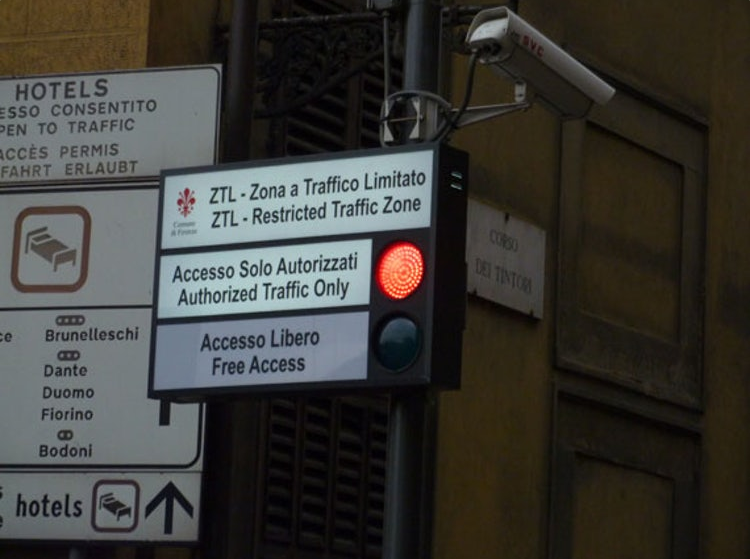
Pay attention to these signs when driving in a city with ZTL zones. Video surveillance cameras (shown above) photograph ALL vehicles entering the zone and report the license plate numbers to the local authorities who compare it to “white list” database to verify if the vehicle has an active permit. If you are in the zone illegally you will likely receive hefty fines.
What if my hotel is in a restricted driving zone?
This was the case when we stayed in Florence. We had rented an apartment one block from the Duomo which was well inside the ZTL zone. Many hotels/apartments will kindly submit your vehicle information to the authorities to have it added to the white list. However, they are charged a fee for this so some may not be willing to. Check with your hotel or lodging prior to arriving to see how they handle this. If you plan to park in a public parking garage within the ZTL zone, the attendants will submit your information at no additional charge. This will prevent you from being fined later on.
Finishing Up
Planning a European road trip might sound a bit daunting to anyone who has never traveled to Europe before. There is a lot to keep in mind especially when traveling between different countries. However, it’s actually extremely rewarding for the freedom it provides. Think of being able to go wherever you want whenever you want and not be at the mercy of adhering to a train or bus schedule, or relying on finding a taxi or Uber. There are some topics this article didn’t cover, such as pumping gas in Europe (which is a little different than the United States). If you have any questions about something I didn’t cover, or something that would make your planning a bit less stressful, I’d be happy to help! Feel free to send me an e-mail or drop me a line in the comments section below.
I really appreciate you reading my blog, and I hope you enjoyed this article. If you would like to be notified of my next article, please fill out the subscribe form on the right bar of this page (scroll down for mobile devices). Thank you so much for your support! Happy travels!
Disclosure: There are some affiliate links on this page. While the prices of the items displayed on this website are no different than on each advertisers websites, we do earn a commission if you choose to purchase. Thank you for supporting Off with the Kids and helping us share our adventures!







Great information . Very interesting . Good job!
Thank you!
Amazing post! Informative and well- written!
Thank you so much!
Also, pay attention to where you park your car. There are some restricted areas especially in big cities, which are not thoroughly labeled.
A brilliant article! We also did an European road trip in April 2018 but our route was UK-France-Belgium-Germany-Austria-Slovenia-Croatia-Serbia-Bulgaria. The Alps truly look amazing! Just one minor correction – the shortest duration vignette available for Bulgaria is 2 days (a Weekend vignette, which is valid from 12 noon on Friday till 23:59 Sunday).
Thank you so much for the comment and kind words. It’s much appreciated! Thank you for the tip on the Bulgaria vingette. We haven’t been to Bulgaria yet, so I had to go based on what I found online. I will make the correction. 🙂